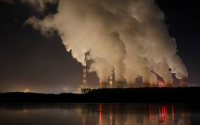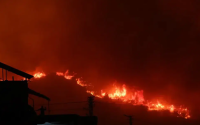July 2, 2004 Yereth Rosen ANCHORAGE, Alaska - A warming climate is bringing expensive and potentially dangerous erosion and floods to Native Alaskan villages, representatives of those communities told federal officials this week. Storms tear off chunks of beach once shielded by permafrost or Arctic pack ice. Buildings are in danger of toppling into the sea, and many have already been moved, at great expense. Airstrips are swamped and ice cellars that once stored food in the permafrost are filling with water, residents say. "As the calming hand of the ice on the Arctic Ocean grows more fragile, so does our coastline," Barrow Mayor Edith Vorderstrasse told members of the U.S. Senate Appropriations Committee during a two-day field hearing in Anchorage. "We are at a crossroads. Is it practical to stand and fight our mother ocean? Or do we surrender and move?" Fixing the problems by expanding seawalls or relocating entire towns could cost hundreds of millions of dollars for each village, according to General Accounting Office estimates presented at the hearing. Of the 213 Native Alaskan villages, 184 face flooding and erosion problems, with very serious problems in about 20, the GAO says. Tough rules for securing federal aid, requiring local matching funds and cost-benefit analyzes, leave many villages out in the cold, local officials say. For residents of Shishmaref, a coastal village of 600 with severe erosion problems, abandoning their ancestral homeland with its traditional food supply "would have a devastating impact on how we exist and who we are," said Luci Eningowuk, chairman of the Shishmaref Erosion and Relocation Coalition. Residents have already moved 18 homes and two National Guard buildings. Two years ago they voted to move the entire town inland but have not yet secured the money to relocate. Senator Ted Stevens, the Alaska Republican who chairs the committee and called the hearing, said villagers' complaints about standards for federal aid were valid. "There's no tax base. Most of them have absolutely no industrial base at all," he said during a break in the hearing. And it is unfair to blame the Native Alaskans for living in what are now vulnerable spots, Stevens said. He cited the Inupiat village of Point Hope, established 2,600 years ago on the northwestern Alaska coast. Flooding problems will likely force the village of 725 people to move, or build a costly road offering an escape route. "It's been there since before the birth of Christ. You can't quite say the decision to locate their village, when it was made, was right or wrong," Stevens said. Vorderstrasse, whose town of 4,400 is the northernmost community in the United States, has no doubt that global warming is behind the erosion, which disrupts whaling and goose hunting. "We've had rain in January. We had a real early spring in April," she said. "Our weather pattern is really different. It's not consistent like it used to be." The earth's warming trend, which most scientists say is accelerated by the trapping of pollutants in the atmosphere, is more dramatic at polar latitudes. Scientists at the University of Alaska Fairbanks say air temperatures in Alaska, Siberia and Canada have risen 1 degree Celsius (2 degrees Fahrenheit) per decade, compared to the global average of 0.6 degree Celsius (1.2 degrees Fahrenheit) per century. "Whether it's natural or global climate change, our state is having an impact greater than any other part of the United States," Stevens said. But a colleague, Senator Conrad Burns, rejects the idea that pollution-induced global warming is to blame for the erosion in rural Alaska. "I haven't bought off on global warming yet," the Montana Republican said. "I don't think it's man-made. The earth is in constant change all the time." Still, he said, federal aid will get to the Native villages. "Congress responds, as a rule, to disasters and catastrophes. They just do it, because we're a compassionate country," he said. © Copyright 2004 Reuters Ltd |






